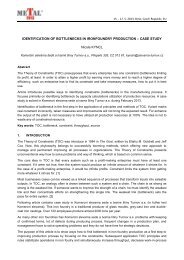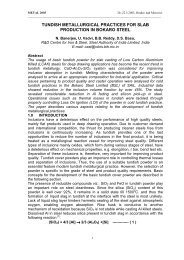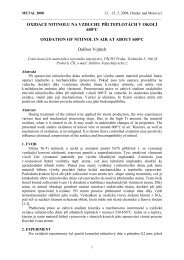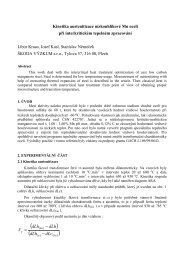ferritic rolling to produce deep-drawable hot strips of steel - metal 2013
ferritic rolling to produce deep-drawable hot strips of steel - metal 2013
ferritic rolling to produce deep-drawable hot strips of steel - metal 2013
You also want an ePaper? Increase the reach of your titles
YUMPU automatically turns print PDFs into web optimized ePapers that Google loves.
FERRITIC ROLLING TO PRODUCE DEEP-DRAWABLE HOT STRIPS<br />
OF STEEL<br />
Radko Kaspar<br />
Andreas Tomitz<br />
a) MAX-PLANCK-INSTITUT FÜR EISENFORSCHUNG GmbH, Düsseldorf, Germany<br />
b) HOESCH HOHENLIMBURG GmbH, Hohenlimburg, Germany<br />
Abstract<br />
The aspired good <strong>deep</strong>-drawability (high r- and n-values, Δr . 0) is basically achieved by a<br />
definite anisotropic flow mechanism. Such necessary anisotropy can be ensured in a <strong>deep</strong><strong>drawable</strong><br />
<strong>steel</strong> sheet by a preferential {111}||ND-texture. In a conventional production, a <strong>hot</strong><br />
<strong>rolling</strong> in austenite and a cold <strong>rolling</strong> at room temperature <strong>to</strong>gether with a subsequent recrystallization<br />
annealing are applied for such texture development in the final cold strip. As a cost saving<br />
replacement for this, a thin-gauge <strong>hot</strong> strip with a required <strong>deep</strong>-drawability can be employed.<br />
As a promising realization <strong>of</strong> cost saving thin-gauge <strong>deep</strong>-<strong>drawable</strong> <strong>hot</strong> <strong>strips</strong> <strong>of</strong> <strong>steel</strong>, a <strong>ferritic</strong><br />
<strong>rolling</strong> can be implemented. In this new practice the finishing is shifted down in<strong>to</strong> the temperature<br />
region <strong>of</strong> ferrite. To optimize the process parameters, extensive labora<strong>to</strong>ry tests on IF <strong>steel</strong><br />
were carried out by using the <strong>hot</strong> deformation simula<strong>to</strong>r WUMSI. By the measurements <strong>of</strong> the<br />
texture development as well as by the computing <strong>of</strong> r-values, the texture formation could be<br />
optimized achieving a <strong>deep</strong>-drawability in <strong>hot</strong> <strong>strips</strong> comparable <strong>to</strong> that <strong>of</strong> a cold strip after a<br />
conventional austenitic <strong>rolling</strong>.<br />
1. DEEP-DRAWABILITY OF STEEL<br />
A good cold workability (low pro<strong>of</strong> strength, high uniform elongation) additionally <strong>to</strong> a<br />
sufficient strength (after cold forming) and, particularly, a good <strong>deep</strong>-drawability are the properties<br />
that are <strong>of</strong> a large importance for many flat products <strong>of</strong> <strong>steel</strong>. The aspired good <strong>deep</strong>drawability<br />
can be realized by a favorable anisotropic material flow during the <strong>deep</strong>-drawing<br />
process.<br />
For the anisotropic flow behavior <strong>of</strong> a polycrystalline material the distribution <strong>of</strong> the orientations<br />
<strong>of</strong> individual grains plays a decisive<br />
role and is determining for the r-values 1,2) .<br />
Outgoing from a statistic disorderly<br />
distributed grain orientations, r-value<br />
increases with increasing fraction <strong>of</strong><br />
{111}-oriented grains and decreasing<br />
amount <strong>of</strong> those with {100} orientation<br />
parallel <strong>to</strong> sheet plane, Fig. 1 3) 3.0<br />
parallel <strong>to</strong> sheet plane<br />
2.0<br />
.<br />
{111} {100}<br />
2. DEEP-DRAWABLE STRIPS<br />
PRODUCED BY CONVENTIONAL<br />
ROLLING<br />
To realize the requirements for <strong>deep</strong><strong>drawable</strong><br />
<strong>steel</strong>s with a pronounced {111}texture<br />
by a conventional route, <strong>hot</strong> <strong>rolling</strong><br />
is traditionally carried out in the austenite<br />
range followed by cold <strong>rolling</strong> with a<br />
r -value [-]<br />
m<br />
1.0<br />
0.0<br />
orientation:<br />
rm-value theoretical:<br />
{111}<br />
2.9<br />
{554}<br />
0.1 1 10 100 1000<br />
Volume ratio <strong>of</strong> {111} and {100} grains (I {111} / I {100} )<br />
2.8<br />
{211}<br />
2.3<br />
{110}<br />
1.8<br />
{100}<br />
Figure 1. Effect <strong>of</strong> texture on the mean r-value r m.<br />
I{111} and I{100} are the texture intensities <strong>of</strong> the<br />
corresponding orientations<br />
0.1
sufficient deformation (70 - 80 %) and a<br />
subsequent batch or continuous annealing for<br />
recrystallization. A cold strip is a final product<br />
in such case. In order <strong>to</strong> reduce production<br />
costs there is a tendency <strong>to</strong> achieve a sufficient<br />
<strong>deep</strong>-drawability without cold <strong>rolling</strong>, that<br />
means already with a <strong>hot</strong> strip as a final<br />
product. Fast developments <strong>of</strong> the <strong>rolling</strong><br />
technique make it possible <strong>to</strong> <strong>produce</strong> so-called<br />
thin-gauge <strong>hot</strong> <strong>strips</strong> with minimum<br />
thicknesses that are nowadays within the range<br />
<strong>of</strong> those <strong>of</strong> cold <strong>strips</strong>, Fig. 2 4) . Such<br />
production requires unavoidably lowering<br />
finishing temperatures because <strong>of</strong> large heat<br />
losses <strong>of</strong> thin <strong>hot</strong> <strong>strips</strong>. But, the austenitic<br />
<strong>rolling</strong> with low finishing temperatures is not<br />
easy <strong>to</strong> perform because <strong>of</strong> high transformation<br />
temperatures <strong>of</strong> extra low carbon <strong>steel</strong>s (ELC),<br />
ultra low carbon <strong>steel</strong>s (ULC) and low carbon<br />
interstitial free (IF) <strong>steel</strong>s with manganese<br />
content less than 0.2 %. The reheating<br />
temperatures above 1250 °C would be<br />
necessary for thicknesses <strong>of</strong> 2 - 5 mm. Hot<br />
<strong>strips</strong> thinner than 1.8 mm are not producible at<br />
all by a conventional “austenitic” <strong>hot</strong> <strong>rolling</strong>.<br />
3. DEEP-DRAWABLE THIN-GAUGE<br />
HOT STRIPS PRODUCED BY FERRITIC<br />
ROLLING<br />
The difference in the processing routes <strong>of</strong><br />
a conventional austenitic <strong>rolling</strong> and a novel<br />
<strong>ferritic</strong> <strong>rolling</strong> is apparent from Fig. 3.<br />
Consider-able cost reductions may be<br />
achieved in different way. The most evident<br />
is a reduced reheating temperature in the<br />
<strong>ferritic</strong> <strong>rolling</strong> practice, which gives also the<br />
potential for an increased throughput <strong>of</strong> the<br />
furnace. Lower reheating temperatures for<br />
<strong>ferritic</strong> <strong>rolling</strong> (between 950 and 1050 °C)<br />
result <strong>to</strong> a reduced AlN dissolution<br />
(enhancing ferrite recrystallization kinetics)<br />
and a smaller initial austenite grain size.<br />
This low <strong>rolling</strong> temperature practice leads<br />
also <strong>to</strong> an im-proved <strong>hot</strong> rolled product<br />
Flow stress, MPa<br />
Minimum <strong>hot</strong> strip thickness, mm<br />
1.5<br />
1.0<br />
0.5<br />
0.0<br />
1.6<br />
0.9<br />
60% <strong>of</strong><br />
cold strip<br />
production<br />
0.7<br />
1995 1998 future<br />
Figure 2. Minimum thicknesses <strong>of</strong> <strong>hot</strong> strip as a<br />
potential substitution <strong>of</strong> cold strip<br />
a)<br />
roughing<br />
�<br />
b)<br />
finishing<br />
260<br />
220<br />
180<br />
140<br />
100<br />
60<br />
ELC<br />
IF<br />
���� - transformation ELC<br />
���� - transformation IF<br />
700 800 900 1000 1100 1200<br />
Deformation temperature, °C<br />
Figure 4. Flow stress for � = 0.8 <strong>of</strong> ELC and IF <strong>steel</strong><br />
over the range <strong>of</strong> deformation temperatures (strain<br />
-1<br />
rate 10 s )<br />
quality with less surface defects, improved flatness <strong>of</strong> the <strong>hot</strong> <strong>strips</strong> due <strong>to</strong> reduced internal<br />
stresses owing <strong>to</strong> the fact that <strong>steel</strong> <strong>strips</strong> are already transformed prior <strong>to</strong> cooling on the run-out<br />
table.<br />
Temperature<br />
�����<br />
�<br />
C Mn<br />
coiling<br />
Time Time<br />
Figure 3. Comparison <strong>of</strong> conventional austenitic (a)<br />
and <strong>ferritic</strong> (b) <strong>rolling</strong><br />
�����<br />
�<br />
roughing<br />
coiling<br />
�<br />
finishing
Fortunately, moderate <strong>rolling</strong> loads in the<br />
finishing mill enable the application <strong>of</strong><br />
<strong>ferritic</strong> <strong>rolling</strong> even on existing mills. As<br />
shown in Fig. 4 5) , the flow stresses - and so<br />
the <strong>rolling</strong> loads - <strong>of</strong> the IF <strong>steel</strong> are lower in<br />
the temperature range between 870 and<br />
700 °C than those at 950 °C in the<br />
conventional austenitic temperature region.<br />
At lower temperatures higher flow stresses<br />
<strong>of</strong> ELC <strong>steel</strong> are measured presumably due<br />
<strong>to</strong> dynamic strain aging in these <strong>steel</strong> grades.<br />
Two different groups <strong>of</strong> <strong>ferritic</strong> rolled <strong>deep</strong><strong>drawable</strong><br />
thin-gauge <strong>hot</strong> <strong>strips</strong> can be<br />
<strong>produce</strong>d, Fig. 5:<br />
“S<strong>of</strong>t” <strong>hot</strong> strip: In this product group<br />
the coiling condition must guarantee a<br />
complete recrystallization in the coil<br />
(becoming s<strong>of</strong>t), Fig. 5a. For this, the<br />
finishing and coiling temperatures must<br />
be appropriate high.<br />
`HardA <strong>hot</strong> strip annealed: By further<br />
lowering finishing temperatures in this<br />
processing, compared <strong>to</strong> the production<br />
<strong>of</strong> s<strong>of</strong>t <strong>hot</strong> strip, thinner <strong>hot</strong> <strong>strips</strong> can<br />
be <strong>produce</strong>d (< 1 mm). Such <strong>hot</strong> strip<br />
does not recrystallize in coil (becoming<br />
hard) and must additionally be recrystallized<br />
by annealing, Fig. 5b.<br />
Temperature<br />
a) ����� b)<br />
finishing � annealing<br />
coiling<br />
Time<br />
Time<br />
�����<br />
�<br />
Figure 5. Production <strong>of</strong> „s<strong>of</strong>t“ <strong>hot</strong> strip (a) and<br />
„hard“ <strong>hot</strong> strip additionally annealed (b)<br />
�<br />
� -fibre<br />
� 1<br />
� 2<br />
{111}<br />
{111}<br />
{111}<br />
{ 11 0}<br />
{001}<br />
{112}<br />
� -fibre<br />
Figure 6. Eulerian space showing the position <strong>of</strong> �-<br />
and �-fibres<br />
(a)<br />
4. TEXTURE DESCRIPTION<br />
For the description <strong>of</strong> texture development the method <strong>of</strong> grain orientation distribution (ODF)<br />
is the most applied way. 6) In a so-called Eulerian space each point corresponds <strong>to</strong> one orientation,<br />
defined by three Eulerian angles Φ, ν1 and ν2, Fig. 6. For practical purposes the key textures in<br />
<strong>steel</strong> sheets can be followed by the focusing<br />
only some special lines in this space,<br />
so-called fibres, in the Eulerian space. For<br />
<strong>deep</strong>-<strong>drawable</strong> <strong>steel</strong> sheets two fibres are<br />
important: α-fibre ( || RD) and γ-fibre<br />
({111} || ND). In this way the pole densities can<br />
be expressed only along these two fibres in the<br />
form <strong>of</strong> two 2D-diagrams.<br />
The texture development in simulated warm<br />
(<strong>ferritic</strong>) rolled <strong>strips</strong> was the main objective <strong>of</strong><br />
this work. The study was focused on the<br />
potential final products mentioned above: a<br />
“s<strong>of</strong>t” <strong>hot</strong> strip and a “hard” <strong>hot</strong> strip<br />
additionally annealed.<br />
Finishing temperature, °C<br />
840<br />
800<br />
760<br />
720<br />
partially<br />
recrystallized<br />
completely<br />
recrystallized<br />
680<br />
hardly<br />
recrystallized<br />
not realizable<br />
640<br />
600 620 640 660 680 700 720 740<br />
Coiling temperature, °C<br />
Figure 7. The region <strong>of</strong> a complete ferrite<br />
recrystallization <strong>of</strong> the IF <strong>steel</strong> presented in the<br />
coordinate system <strong>of</strong> finishing temperature and<br />
coiling temperature
5. MATERIAL AND EXPERIMENTAL<br />
TECHNIQUE<br />
The investigations were done on an IF-<strong>steel</strong> as a<br />
typical representative <strong>of</strong> <strong>deep</strong>-<strong>drawable</strong> <strong>steel</strong>s. The<br />
chemical composition was as follow (in mass %):<br />
C: 0.002%, Si: 0.007%, Mn: 0.097%, P: 0.010%,<br />
S: 0.004%, N: 0.003%, Al: 0.042%, Ti: 0.038%,<br />
Nb: 0.007%. The labora<strong>to</strong>ry tests were done on the<br />
<strong>hot</strong> deformation simula<strong>to</strong>r WUMSI 7) by using the<br />
plane strain <strong>hot</strong> compression test as a simulation<br />
<strong>of</strong> <strong>rolling</strong>. The texture was measured on a Siemens<br />
D500 texture goniometer. The r-values were<br />
computed from the texture measurements by an<br />
“ANIS-MPI” program <strong>of</strong> the University Birmingham.<br />
8)<br />
Texture intensity<br />
Texture intensity<br />
10<br />
8<br />
6<br />
4<br />
2<br />
0<br />
� - fibre : ||RD<br />
0 15 30 45 60 75 90<br />
�<br />
- fibre: {111} ||ND<br />
{001} {112} {111} {110} <br />
710°C<br />
710°C<br />
810°C<br />
760°C<br />
austenite<br />
940°C<br />
10<br />
60 75 90<br />
� [°] � 1 [°]<br />
Figure 8. Deformation texture for different finishing<br />
temperatures<br />
6. RESULTS AND DISCUSSION<br />
For the design <strong>of</strong> the <strong>rolling</strong> schedules in ferrite region the determination <strong>of</strong> the range <strong>of</strong> the γα-transformation<br />
temperatures as well as the knowledge <strong>of</strong> the recrystall-ization behavior <strong>of</strong><br />
ferrite is indispensable. Fig. 7 shows the range <strong>of</strong> coiling temperatures in which ferrite can<br />
recrystallize completely in coil in the production <strong>of</strong> “s<strong>of</strong>t” <strong>hot</strong> <strong>strips</strong>. Coiling bellow this temperatures<br />
leads <strong>to</strong> a “hard” <strong>hot</strong> strip that has <strong>to</strong> be additionally annealed <strong>to</strong> achieve a designed<br />
texture.<br />
6.1. Deep-<strong>drawable</strong> "s<strong>of</strong>t" <strong>hot</strong> strip<br />
In the development <strong>of</strong> texture during the production <strong>of</strong> <strong>deep</strong>-<strong>drawable</strong> <strong>hot</strong> strip, the deformation<br />
texture just after finishing is decisive for the quality <strong>of</strong> the recrystallized texture after coiling.<br />
Generally, the deformation texture should involve a sufficient intensity <strong>of</strong> γ-fibre including<br />
typically some component <strong>of</strong> {001} as well. After finishing with ε = 4 x 0.3 the deformation<br />
texture was measured for various finishing<br />
temperatures in ferrite and compared with<br />
that after finishing in austenite, Fig. 8. The<br />
high finishing temperature in ferrite<br />
(810 °C) leads <strong>to</strong> an unfavorable <strong>rolling</strong><br />
texture with a poor coverage <strong>of</strong> {111} and<br />
� - fibre : ||RD<br />
{001} {112} {111}<br />
10<br />
after finishing<br />
8 at 710 °C<br />
� - fibre: {111} ||ND<br />
{110} <br />
10<br />
8<br />
the maximum amount <strong>of</strong> grains with α-fibre<br />
near <strong>to</strong>{001} component. By reducing<br />
6<br />
6<br />
finishing temperature (760 °C or lower) a<br />
more distinctive γ-fibre components with a<br />
4<br />
4<br />
strongest coverage <strong>of</strong> α-fibre in the range <strong>of</strong> 2<br />
2<br />
{112} can be observed. In contrast <strong>to</strong> <strong>ferritic</strong><br />
rolled specimens, there is nearly irregular 0<br />
after coiling at 670 °C<br />
0<br />
texture with random oriented grains after the<br />
γ-α-transformation <strong>of</strong> austenitic rolled <strong>steel</strong>,<br />
as also reported in.<br />
0 15 30 45 60 75 90 60 75 90<br />
� [°]<br />
� [°]<br />
1<br />
Figure 9. Texture development in the simulated “s<strong>of</strong>t”<br />
<strong>hot</strong> strip showing the change <strong>of</strong> the deformation<br />
texture just after finishing in<strong>to</strong> a recrystallized texture<br />
after coiling (see arrows)<br />
9)<br />
Fig. 9 displays the texture development <strong>of</strong><br />
a favorable deformation texture (a low<br />
8<br />
6<br />
4<br />
2<br />
0
finishing temperature <strong>of</strong> 710 °C) due <strong>to</strong> the recrystallization<br />
in coil. The formation <strong>of</strong> a typical annealing texture with a<br />
strong γ-fibre orientation and a reduced coverage <strong>of</strong> {001}<br />
component <strong>of</strong> α-fibre can be observed. There is a striking<br />
increase in the component <strong>of</strong> γ-fibre.<br />
As observed, the lowering finishing temperature improves<br />
the deformation texture with an increasing amount <strong>of</strong> {111}<br />
oriented grains which supports the formation <strong>of</strong> a sharper<br />
{111} recrystallized texture after coiling. This is reflected by<br />
a significant increase in r-values (as computed from the<br />
texture measurements) with decreasing finishing temperature,<br />
Fig. 10.<br />
6.2. Deep-<strong>drawable</strong> “hard” <strong>hot</strong> strip<br />
By a further lowering <strong>of</strong> finishing temperature thinner <strong>hot</strong><br />
<strong>strips</strong> with a more favorable <strong>rolling</strong> texture can be <strong>produce</strong>d.<br />
r-value [-]<br />
2.0<br />
1.5<br />
1.0<br />
0.5<br />
ferrite deformation: � = 1.2<br />
finishing at 710°C<br />
760°C<br />
860°C<br />
0<br />
0(r) 0 45 (r 45)<br />
90 (r 90)<br />
Angle <strong>to</strong> <strong>rolling</strong> direction [°]<br />
Figure 10. Effect <strong>of</strong> finishing<br />
temperature on the r-values <strong>of</strong><br />
simulated “s<strong>of</strong>t” <strong>hot</strong> <strong>strips</strong><br />
Nevertheless, the coiling temperature becomes <strong>to</strong>o low for a complete recrystall-ization <strong>of</strong> the<br />
warm deformed material in the coil and, therefore, an additional recrystallization annealing is<br />
necessary by using batch or continuous processing.<br />
The texture development during a batch annealing <strong>of</strong> specimens finished at 660 °C with two<br />
different coiling temperatures is given in Fig. 11. Whereas the higher coiling temperature <strong>of</strong><br />
550 °C leads <strong>to</strong> a rather low γ-fibre coverage, the lower coiling temperature <strong>of</strong> 400 °C brings<br />
about a significant improvement in texture with a high level <strong>of</strong> γ-fibre showing a maximum at<br />
the {111} component. This is supposed <strong>to</strong> reflect the recovery processes during the coiling<br />
at higher temperatures that reduce the s<strong>to</strong>red energy surplus <strong>of</strong> {111}-oriented grains and so<br />
diminish their amount after recrystallization.<br />
The r-value distributions after the simulation both <strong>of</strong> the possible annealing processes (batch<br />
and continuous), are displayed in Fig 12. The<br />
distribution <strong>of</strong> r-values as a function <strong>of</strong> the<br />
angle <strong>to</strong> RD shows considerably higher values,<br />
especially in RD (r 0), in comparison <strong>to</strong> those <strong>of</strong><br />
“s<strong>of</strong>t” <strong>hot</strong> <strong>strips</strong>. So the form <strong>of</strong> the curves is<br />
more similar <strong>to</strong> that <strong>of</strong> cold <strong>strips</strong>. The mean rvalues<br />
> 1.5, Δr < 0.6 as well as other<br />
mechanical properties (elongation A > 50 %,<br />
0.2%-pro<strong>of</strong> strength Rp0.2
G By reducing finishing temperature <strong>of</strong> <strong>ferritic</strong> <strong>rolling</strong><br />
a more favorable initial <strong>rolling</strong> texture can be<br />
generated as a pre-condition for a beneficial final<br />
recrystallized texture.<br />
G A minimum coiling temperature (670 °C for the IF<strong>steel</strong><br />
tested) must be met if producing <strong>deep</strong><strong>drawable</strong><br />
“s<strong>of</strong>t” <strong>hot</strong> <strong>strips</strong> directly after coiling.<br />
G By a further lowering <strong>of</strong> finishing and coiling<br />
temperature (<strong>to</strong> achieve even lower <strong>hot</strong> strip<br />
thicknesses) “hard” (not recrystallized) <strong>hot</strong> <strong>strips</strong><br />
must additionally be annealed after coiling <strong>to</strong><br />
guarantee a complete recrystall-ization. Lower<br />
coiling temperatures are more desirable for these<br />
products.<br />
r-value [-]<br />
3.0<br />
2.5<br />
2.0<br />
1.5<br />
1.0<br />
0.5<br />
batch annealing<br />
at 700 °C<br />
continuous annealing<br />
at 780 °C<br />
0<br />
0(r) 0 45 (r 45)<br />
90 (r 90)<br />
Angle <strong>to</strong> <strong>rolling</strong> direction [°]<br />
Figure 12. r-values after different<br />
simulated annealing procedures<br />
applied on the “hard” <strong>hot</strong> strip<br />
(finishing at 660°C, coiling at<br />
400°C)<br />
REFERENCES<br />
[1] SCHLIPPENBACH, U. v.; LÜCKE, K.: Deformation and recrystallization tex-tures in a low-C<strong>steel</strong>,<br />
ICOTOM 7, Holland, 1984, pp. 159 - 164.<br />
[2] PLUTKA, B.: Untersuchungen zu Vorgängen bei der Bildung von Rekristallisationstexturen<br />
in Tiefzieh-stählen, Dissertation RWTH Aachen, Germany, 1991.<br />
[3] RAY, R. K.; JONAS, J. J.; HOOK, R, R. E.: Cold <strong>rolling</strong> and annealing textur-es in low carbon<br />
and extra low carbon <strong>steel</strong>s, Int. Mat. Rev. 39 (1994) 4, pp. 129-172.<br />
[4] BALD, W.; KNEPPE, G.; ROSENTHAL, D.; SUDAU, P.: Innovative Techno-logie zur Banderzeugung,<br />
stahl und eisen 119 (1999) 9, pp.77-85.<br />
[5] TOMITZ, A.; KASPAR, R.: Laborsimulation zur Optimierung der Prozeßparameter und der<br />
Produktqualität von Tiefziehstählen beim Warmwalzen im Ferritgebiet, Proc. <strong>of</strong> the 13.<br />
Aachener Stahlkolloquium Umformtechnik Stahl- und NE-Werks<strong>to</strong>ffe, Ed. by R. Kopp, Verlag<br />
Mainz, Wissenschaftsverlag, Aachen, Germany, 1998, pp. 5.4-1 - 5.4-4.<br />
[6] BUNGE, H.-J.: Mathematische Methoden der Texturanalyse; Akademie-Verlag, Berlin, 1969.<br />
[7] KASPAR, R.; STREIßELBERGER, A.; PEICHL, L.; PAWELSKI, O.: Fortgeschrittene Technik der<br />
Warmumformsimulation. Z. Werks<strong>to</strong>fftech. 14 (1983), pp. 272 - 277.<br />
[8] BATE, P. S.: Manual for ANSI-MPI, University <strong>of</strong> Birmingham, 1997:<br />
[9] RAY, R.K.; JONAS, J.J.: Transformation textures in Steels. Int. Mat. Rev. 35 (1990) 1, pp. 1<br />
- 35.








